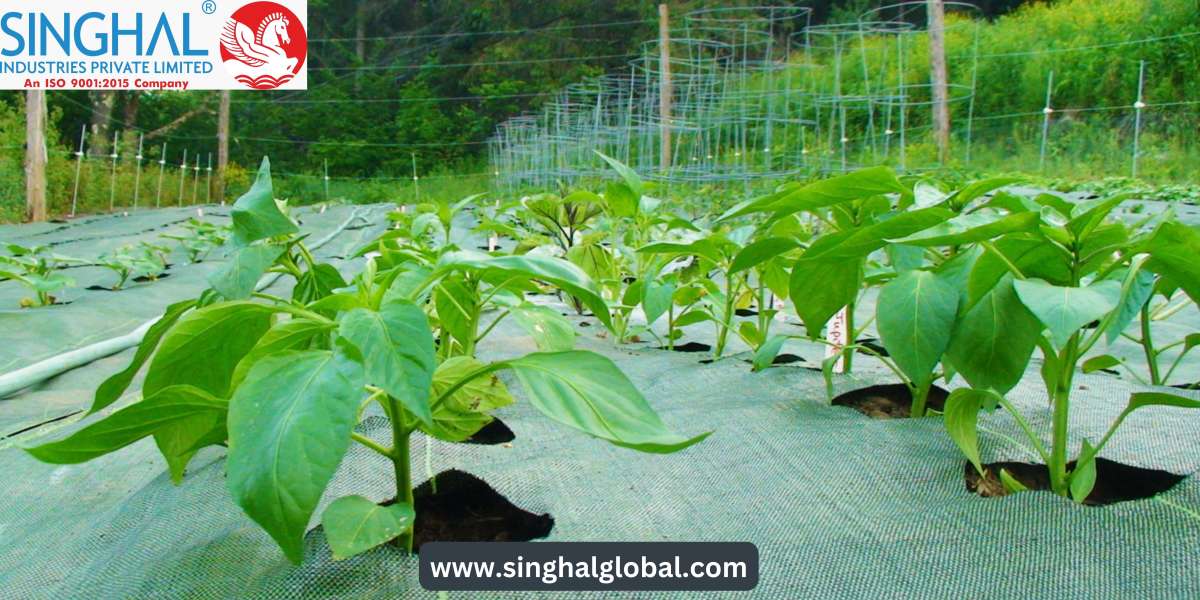Weed mats are a game-changer for gardeners and landscapers alike. They offer an eco-friendly and efficient solution to keep unwanted plants at bay without the need for chemical herbicides. But what exactly are Weed matting fabric, and how can they benefit your outdoor space? This guide delves deep into the world of weed matting, exploring the different types, their benefits, and how to use them effectively.
What is a Weed Mat?
A weed mat is a specially designed fabric or material that is placed over the soil to prevent weed growth. It acts as a barrier between the sun and the weeds, depriving them of the light they need to grow. Available in various types, weed mats are essential for maintaining a weed-free garden with minimal effort.
Overview of Weed Matting Fabric
Weed matting fabric is usually made from durable, permeable materials that allow water and nutrients to reach the soil while blocking sunlight. This fabric is easy to install and comes in rolls that can be cut to fit the required area.
Weed Prevention Mat: How it Works
Weed prevention mats work by suppressing the growth of weeds through physical obstruction. The fabric’s dense weave blocks light, and some designs are even treated with UV protection to prevent degradation from sunlight exposure.
Weed Suppressing Mat: Key Benefits
- Reduces the need for frequent weeding
- Conserves soil moisture by limiting evaporation
- Promotes healthier plant growth by minimizing competition for nutrients
- Environmentally friendly by reducing chemical herbicide use
Types of Weed Mats Available
There are two main types of weed mats: organic and synthetic. Each has its pros and cons, depending on the specific needs of your garden.
Organic Weed Mats
Made from natural materials such as jute or straw, organic weed mats decompose over time, enriching the soil with organic matter. These mats are perfect for eco-conscious gardeners who prioritize sustainability.
Synthetic Weed Mats
Synthetic weed mats, often made from polypropylene or polyethylene, are more durable and long-lasting than their organic counterparts. They are resistant to rot, making them ideal for areas with high moisture levels or frequent rain.
How to Choose the Right Weed Mat for Your Garden
Selecting the right weed mat depends on several factors, such as your garden’s soil type, the climate in your region, and the types of plants you are growing.
Considerations for Weed Matting Fabric
When choosing a weed mat, consider its thickness and permeability. Thicker mats provide better weed suppression, while permeable ones allow water and air to pass through, promoting healthier plant growth.
Comparing Different Weed Suppression Mats
Different weed mats vary in their effectiveness depending on the material and design. Organic mats tend to decompose faster, while synthetic ones offer longer-lasting protection.
Benefits of Using Weed Mats in Landscaping
The use of weed mats in landscaping extends beyond just weed control. They offer several other advantages that make them a worthwhile investment for any garden.
Weed Prevention with Minimal Effort
By installing weed mats, you can significantly reduce the time and effort required for weeding, allowing you to focus on other aspects of gardening.
Enhancing Soil Moisture Retention
Weed mats help maintain soil moisture by limiting evaporation, especially during hot weather. This is particularly beneficial for regions prone to drought.
Weed Mats as a Long-Term Solution
Weed mats provide long-lasting weed control, making them a cost-effective solution for maintaining large gardens or commercial landscapes.
Installation Guide for Weed Mats
Installing a Weed prevention mat is a straightforward process, but doing it correctly is key to achieving the best results. Below is a step-by-step guide to help you install your weed mat effectively and ensure it provides long-term weed control.
Step-by-Step Process for Installing Weed Mats
- Prepare the AreaStart by clearing the area where you plan to install the weed mat. Remove any existing weeds, rocks, or debris from the soil surface to create a smooth, clean base.
- Cut the Weed Mat to SizeMeasure the dimensions of the area and cut the weed mat to fit. Be sure to leave a little extra around the edges so that the mat can be securely anchored into the soil.
- Lay the Mat Over the SoilOnce the mat is cut to the appropriate size, lay it over the soil, ensuring it covers the entire area. For large spaces, overlap the edges of multiple sheets to prevent weeds from growing through the seams.
- Secure the Mat in PlaceUse garden staples or stakes to secure the mat into the soil. Place the stakes at regular intervals along the edges and in the center to keep the mat in place during windy conditions.
- Cut Openings for PlantsIf you are planting through the weed mat, cut small openings where your plants will go. Be sure the openings are just large enough for the plants to grow without exposing too much soil.
- Add Mulch (Optional)For aesthetic purposes and added protection, you can add a layer of mulch over the weed mat. This will help further suppress weeds and improve the overall appearance of your garden.
Best Practices for Weed Suppressing Mats
- Choose the Right Mat: Always choose a weed mat that suits your specific garden needs, whether it’s for vegetable beds, flower gardens, or landscaping.
- Inspect Regularly: Over time, check the mat for any tears or damage, especially after heavy rains or strong winds.
- Anchor Properly: Ensure that the mat is securely anchored to avoid shifting, which could allow weeds to grow around the edges.
Common Mistakes to Avoid When Using Weed Mats
Although weed mats are highly effective, common mistakes during installation and use can reduce their effectiveness. Here are the most frequent errors to watch out for and how to avoid them.
Incorrect Weed Mat Placement
One of the biggest mistakes people make is placing the weed mat too close to plant stems or trunks. This can prevent the plants from receiving enough air and water, and in some cases, lead to root rot. Always leave a small gap around the base of plants to allow for healthy growth.
Choosing the Wrong Type of Weed Mat
Not all weed mats are created equal. Using an unsuitable mat for your garden's needs can reduce its effectiveness. For instance, a thin mat may not suppress aggressive weeds, while a thick, impermeable mat could hinder water drainage in a garden that requires frequent watering.
Maintaining Weed Mats for Long-Term Use
Proper maintenance can significantly extend the life of your weed mat and keep it functioning effectively for years.
Regular Inspection and Replacement
Inspect your weed mats regularly for signs of wear and tear. If you notice any holes, rips, or areas where weeds are growing through, it may be time to patch or replace the mat. Regular maintenance ensures that the weed mat continues to provide maximum weed suppression.
Protecting Your Weed Mat from Damage
Certain environmental factors, such as excessive moisture, heavy foot traffic, or exposure to harsh sunlight, can degrade weed mats over time. Adding a layer of mulch on top can protect the mat from damage and help it last longer.
DIY vs Professional Installation of Weed Mats
Installing weed mats can be a simple DIY project, but in some cases, professional help may be more beneficial.
Pros and Cons of DIY Weed Mat Installation
Pros:
- Cost-Effective: Doing it yourself saves money.
- Personal Satisfaction: DIY installation allows you to control the process and customize the setup to your liking.
Cons:
- Time-Consuming: Depending on the size of the area, it can take considerable time and effort.
- Risk of Errors: Mistakes such as improper placement or securing can reduce the mat's effectiveness.
Why Hire a Professional for Weed Prevention?
Hiring a professional landscaper ensures that the weed mat is installed correctly and efficiently. Professionals have the experience to avoid common mistakes and can also provide additional services, such as soil preparation or mulching, to enhance the mat’s performance.
Environmental Impact of Weed Mats
Weed mats offer an eco-friendly alternative to chemical herbicides, making them a great choice for gardeners who are concerned about the environment.
Eco-Friendly Weed Suppressing Mats
Many weed mats are made from biodegradable materials, such as jute or coconut fiber, which break down naturally over time, enriching the soil without leaving harmful residues.
How Weed Mats Help Reduce Chemical Use
By preventing weed growth without the use of chemicals, Weed suppressing mat help reduce the need for herbicides, which can leach into the soil and groundwater, harming beneficial organisms and plants.
Conclusion
Weed mats are a practical, eco-friendly solution for controlling unwanted plants in your garden or landscape. They offer long-lasting weed prevention while reducing the need for chemical herbicides and frequent weeding. By choosing the right type of weed mat, installing it correctly, and maintaining it over time, you can enjoy a healthier, more beautiful garden with minimal effort.
FAQs About Weed Mats
Can weed mats stop all types of weeds?
Weed mats are highly effective at suppressing most common weeds. However, some persistent weeds may still break through if the mat is damaged or improperly installed.
How long do weed mats last?
The lifespan of weed mats depends on the material. Synthetic mats can last several years, while organic mats decompose over a shorter period.
Do weed mats allow water to pass through?
Yes, most weed mats, especially those made from permeable materials, allow water and air to pass through to the soil. This ensures that your plants still receive essential nutrients and moisture while preventing weed growth.
Can weed mats harm plants?
Weed mats are generally safe for plants, as they only block sunlight to prevent weeds from growing. However, care should be taken during installation to avoid covering plant roots or stems, which could inhibit plant growth.



